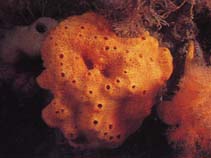Halichondria bowerbanki Burton, 1930
Bowerbanks halichondria
Classification / Names Common names | Synonyms | CoL | ITIS | WoRMS
Demospongiae | Suberitida | Halichondriidae
Environment: milieu / climate zone / depth range / distribution range Ecology
Sessile; depth range 0 - 90 m (Ref. 123733). Temperate; 79°N - 17°N, 128°E - 28°E
Distribution Countries | FAO areas | Ecosystems | Occurrences | Introductions
Arctic, Pacific Ocean and Atlantic Ocean: from Korea, north to Svalbard, south to Mauritania and east to Bulgaria, Black Sea.
Length at first maturity / Size / Weight / Age
Maturity: Lm ? range ? - ? cm
Life cycle and mating behavior Maturity | Reproduction | Spawning | Eggs | Fecundity | Larvae
Main reference
References | Coordinator | Collaborators
Harms, J. 1993 Check list of species (algae, invertebrates and vertebrates) found in the vicinity of the island of Helgoland (North Sea, German Bight) - a review of recent records. Helgoländer Meeresunters 47:1-34. (Ref. 2711)
IUCN Red List Status
(Ref. 130435: Version 2025-1)
CITES status (Ref. 108899)
CMS (Ref. 116361)
Threat to humans
Human uses
| FishSource |
Tools
More information
Diet composition
Food consumption
Predators
Max. ages / sizes
Length-weight rel.
Length-length rel.
Length-frequencies
Mass conversion
Abundance
Internet sources
BHL | BOLD Systems | CISTI | DiscoverLife | FAO(Publication : search) | Fishipedia | GenBank (genome, nucleotide) | GloBI | Gomexsi | Google Books | Google Scholar | Google | PubMed | Tree of Life | Wikipedia (Go, Search) | Zoological Record



